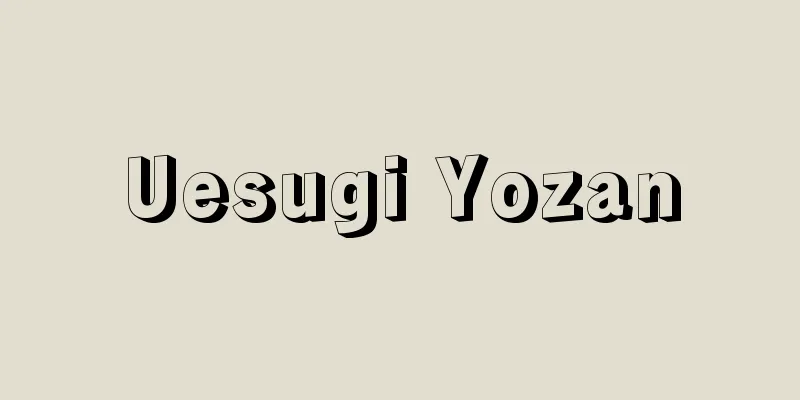Uesugi Yozan

|
Year of death: March 12, 1822 (May 3, 1822) Year of birth: July 20, 1751 (September 9, 1751) The 9th lord of the Yonezawa Domain (Yamagata Prefecture) in the mid-Edo period. Known as a wise ruler. The second son of Akizuki Tanemi, lord of Takanabe Domain (Miyazaki Prefecture). His mother was Haruhime, daughter of Kuroda Nagaharu, lord of Akizuki Domain. His grandmother was Toyohime, daughter of Uesugi Tsunanori. He was born in Edo. He was adopted into the Uesugi family of the Yonezawa Domain. His childhood name was Naomaru, and he changed his name to Harunori after coming of age. Yozan was his later pen name. Yozan became lord of the domain in 1767 (Meiwa 4), and this is when reforms to the domain's government began. Yozan's achievements in leading the reforms can be divided into his time as lord and his time as guardian after retirement. During his time as feudal lord, he implemented the reforms of the Meiwa and An'ei periods, and under the governorship of magistrate Takemata Totsuna, he promoted the establishment of a rural governance system (reforms to the daikan system), the revival of rural areas, the development of industry, and the establishment of the domain school, Kojokan. However, he also practiced thorough frugality, such as only having one soup and one dish for meals, wearing cotton clothing, reducing the number of maids in the house, and cutting his seating fee by one third. In politics, he also aimed for strictness and leniency, and took decisive action against the Seven Family Disturbances, which were perpetrated by senior vassals who opposed the reforms of 1773, and even when Takemata Totsuna, the greatest contributor to the An'ei Reforms, was overthrown, he took strict action. Shortly after Totsuna's punishment, he decided to retire as feudal lord himself, and in 1785, he sent his famous "Message to the Nation" to the new feudal lord, Haruhiro. It consisted of three articles, which warned against monarchical despotism: the state is passed down from ancestors to descendants, the people belong to the state, the state exists for the people, and the monarch cannot do as he pleases. The Kansei Reforms of this period were carried out under the rule of feudal lord Haruhiro, but Yozan's leadership was extremely important. Reforms to the daimyo system were carried out one after another, but new policies were also actively implemented, such as the establishment of a joshibako (official book box), the abolition of the death penalty for gambling that had been established during his time as feudal lord, and measures to diversify national products. The regent at this time was Uesugi Yozan (Taika), who was appointed as a middle elder. Yozan was enthusiastic about learning, and enjoyed reading from his youth. Having studied under the Edo eclectic scholar Hosoi Heisu, Yozan invited Heisu to Yonezawa three times and sent the domain's physician to study in Edo and Nagasaki, widely encouraging the introduction of learning as practical learning. <References> Yokoyama Akio, Uesugi Yozan (Akio Yokoyama) Source: Asahi Japanese Historical Biography: Asahi Shimbun Publications Inc. About Asahi Japanese Historical Biography |
|
没年:文政5.3.12(1822.5.3) 生年:宝暦1.7.20(1751.9.9) 江戸中期の米沢藩(山形県)9代藩主。名君として知られる。高鍋藩(宮崎県)藩主秋月種美の次男。母は秋月藩主黒田長治の娘春姫。祖母は上杉綱憲の娘豊姫。江戸生まれ。米沢藩上杉家の養子に入った。幼少の名は直丸,元服して治憲と改名。鷹山はのちの号名。鷹山が藩主となったのは明和4(1767)年で,米沢藩の藩政改革がそこから始まった。改革の指導についての鷹山の事績は,藩主の時代と隠退後の後見役としての時代に分けられる。藩主時代は,明和・安永期の改革を実施し,奉行竹俣当綱を執政として,農村支配機構整備(代官制改革),農村復興,産業の開発および藩校の興譲館の設立を進めたが,自らも食事は一汁一菜,衣は木綿着とし,奥女中の削減や仕切料を3分の1とするなど,徹底した質素倹約を実行した。政治に当たっても,厳正と寛大を旨とし,安永2(1773)年改革に反対する重臣による七家騒動に対しては,果断な処置をもってのぞみ,安永改革の最大の功労者,竹俣当綱の失脚においても,厳正な処分を行っている。 当綱処分のあと間もなく自らも藩主隠退を決意し,天明5(1785)年新藩主となった治広に対して,有名な「伝国の辞」を贈っている。それは3カ条からなり,国家は先祖より子孫へ伝えるもの,人民は国家に属するもの,国家は人民のためにあるもので,君主が自由にできるものではないという,君主専制を戒めたものである。この期の寛政の改革は藩主治広の治政下にあったが,鷹山の指導力が極めて大きかった。代官制の改革は連続して進められたが,上書箱の設置,藩主時代に制定した博打死刑制の廃止,国産物の多様化策など,新政策も積極的に実施されている。このときの執政は中老として登用された莅戸善政(太華)であった。鷹山は学問を学ぶことに熱心で,青年時代から読書を好んだ。江戸の折衷学者細井平洲を師とする鷹山は,3度平洲を米沢に招いたり,藩医を江戸や長崎に遊学させるなど,実学として広く学問の導入を奨励した。<参考文献>横山昭男『上杉鷹山』 (横山昭男) 出典 朝日日本歴史人物事典:(株)朝日新聞出版朝日日本歴史人物事典について 情報 |
>>: Uesugi-Minobe Debate - Uesugi Minobe Debate
Recommend
Abraham-Hyacinthe Anquetil-Duperron
1731‐1805 An 18th-century French orientalist known...
Chain reaction
This is a reaction in which several reactions occ...
Church Sonata (English: sonata da chièsa)
Along with the chamber sonata, this is an importan...
Alcamo (English spelling)
A city in the province of Trapani in the western p...
Salted skin - Enzouhi
...Depending on the purpose of its use, hides may...
Hatenashi Mountain Range - Hatenashi Sanmyaku
A mountain range stretching east-west for about 30...
Complete goodness
...The principal image is the Amida Buddha. It is...
Old Parr
…Examples of this include the myth of Phoenix and...
Total quality control
...Quality control itself originated in the Unite...
Friedlosigkeit
...However, for example, in the Germanic ancient ...
Magnetic - Immediate
The existence of natural magnets has been known si...
Rokugo [village] - country
A village in Agatsuma County, in the northwest of ...
Mount Komaki
<br /> The remains of a castle in Horiuchi, ...
Cora Sandel
1880‐1974 Norwegian female novelist. Her real name...
Ibn Tashfin
...The monks who listened to his sermons at the r...









